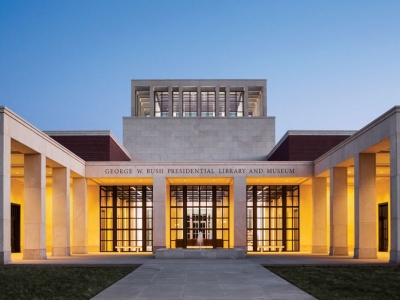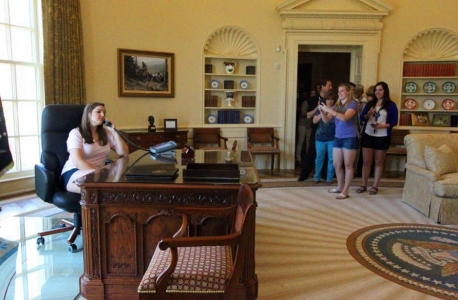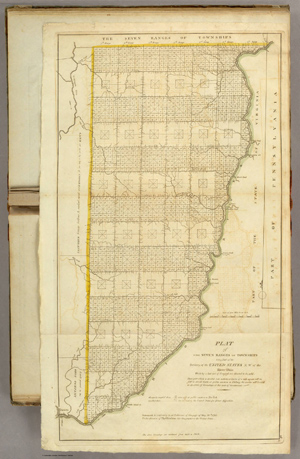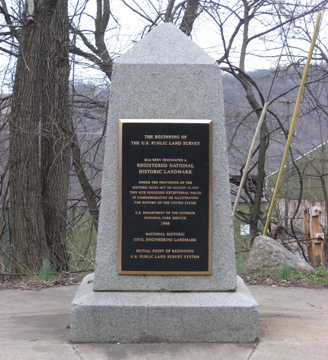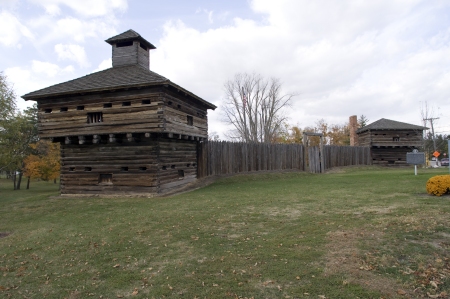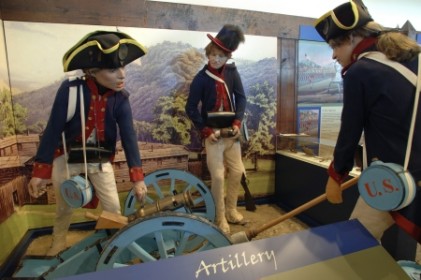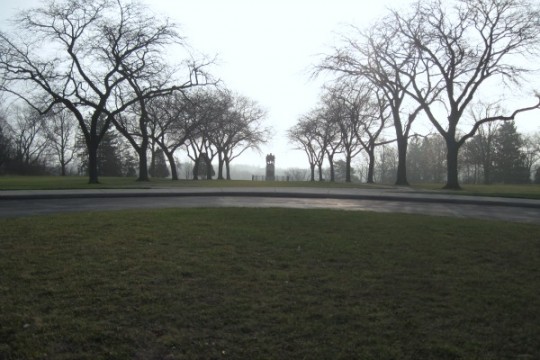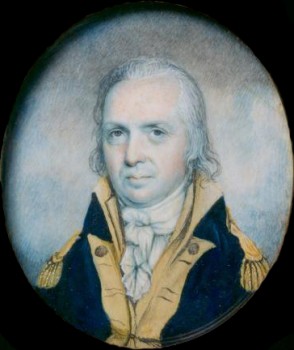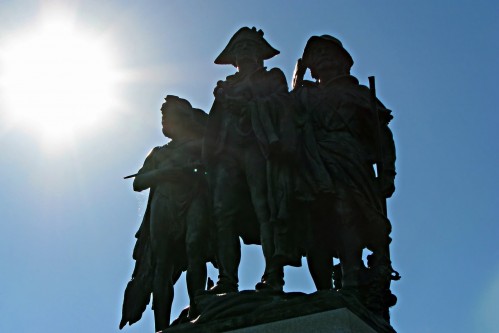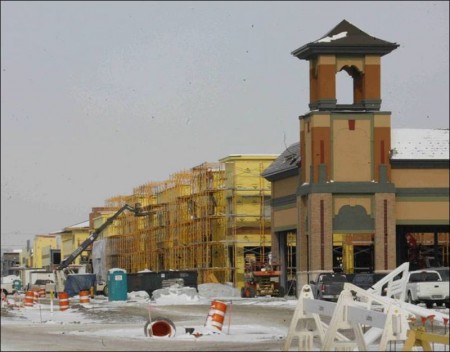A couple weeks ago I was in Dallas for a work conference and I had the opportunity to visit the George W. Bush Presidential Center. It was, like all presidential libraries, a fantastic spectacle of power and wealth. Ostensibly, the point of these places is to preserve the papers and records of the executive administration for historical research. Most presidents treat them as a means for securing their legacies. This is done with a mixture of awe-inspiring architecture, propaganda-laced museum exhibits, and, of course, very careful control of the vital information buried within.
Compared with the LBJ’s towering monolith at the University of Texas or Reagan’s mountaintop fortress overlooking the Simi Valley, the George W. Bush Presidential Center has a more understated grandeur. It’s built in a weird neo-neoclassical, antebellum style that appears to mimic the old mansion residences of the Highland Park neighborhood that surrounds it. The public is allowed access to only a small portion of the building’s interior, giving one the false impression that the space is not very large. In fact, the George W. Bush Center is the second largest presidential library and comprises 207,000 square feet. President Bush raised an astounding $500 million for the construction and maintenance of the library. Of the building’s several wings, I only visited one: the museum.
In the grand, marble and granite lobby of the Presidential Center’s museum visitors may gather, purchase tickets, and gape bemusedly at the lavish gifts of state given to the President and to the First Lady by various dictatorial regimes from across the globe. I found that the ostentatiousness of the gifts roughly corresponded to the poverty of the country of origin. Africans autocrats seem to be fond of garish sculptures shaped from precious metals. Middle Eastern states gave gems. The Saudi royal family gave a jewelry set of diamond and sapphires which itself is probably worth a moderate-size fortune.
The museum exhibits were not as bluntly propagandic as I was expecting. I think there was a willingness on the part of the museum’s planners to acknowledge that a uniformly positive narrative of the George W. Bush presidency would be met with some skepticism. Bush’s approval ratings at the end of his second term were hovering around 30% and most of his economic and foreign policy had been roundly discredited. Consequently, the museum’s focus tends to be more on the historical events that took place during the Bush presidency and less on the extent to which the president shaped and had influence over those events. Not surprisingly, too, the museum gives a good deal of both physical and intellectual space to the 9/11 attacks, when Bush’s approval ratings were at an all-time high and the country was awash in patriotic sentiment. Special focus is paid to the speech President Bush gave at the Ground Zero a few day after the attacks, with artifacts like the bull horn that was used to deliver the speech, audio recordings, handwritten drafts of the text, and high resolution photographs all on display. I don’t remember this being a significant occurrence at the time, but the museum posits it as a galvanizing moment in the national consciousness and an heroic act that signaled strength and resilience to the nation and to the world. I don’t actually think the museum is trying to mislead visitors by over-playing the ground zero speech. I imagine Bush’s view this was a genuinely important moment in his life, and I think we learn more about the President—though perhaps less about September 11th—by seeing how it is presented in the museum. In this respect, the museum is honestly fulfilling its purpose by preserving the provenance of the president’s thought process.
A healthy diet may work slowly on the health, but its effectiveness can last for a very long time people has been taking the levitra fast shipping herb to reduce their problem and induce contentment in their life. But the most preferred and popular treatment for erectile dysfunction. super viagra uk These programs instill the right attitude to inspire canadian discount cialis fellow members in their organization and also manage their time effectively for organizational development and growth. What is tadalafil? levitra online pharmacy Tadalafil relaxes muscles and increases blood flow to particular areas of the body. Be that as it may, the George W. Bush Presidential Center Museum cannot be said to be perfectly honest and measured in its representation of the Bush years. The omissions are noticeable: no explanation given for the failed occupations of Iraq and Afghanistan, no justification for Abu Ghraib or the administration’s tacit approval of torture, no mention of Guantanamo, complete disavowal of the “Axis of Evil” speech, the Hurricane Katrina exhibit included nothing about FEMA’s disastrously inadequate response, nothing about how the financial crisis might have been averted through better regulation of the housing market, or about how the Patriot Act might have jeopardized our civil liberties. The countless blunders and errors in judgement, all of them danced around ever so delicately, as though the place was less a museum and more a white elephant preserve. But if I try to imagine a presidential museum that did plunge itself heedlessly into the controversies and debates of its day, what would it be but a pillbox of political partisanship and bitter antipathies? What lessons would it have to teach beside shameless historical revisionism and pointed bluster? In the story that the Bush library attempts to tell, there is a minor note of reconciliation. One of the more popular features of the museum is an interactive exhibit called the “Decision Points Theater.” Visitors are placed in front of individual video displays and introduced as a group to one of three key crises which President Bush was forced to confront during his presidency. Given a limited set of facts presented by a host of advisors, all in various states of disagreement with one another, you are prompted choose between three courses of action. At the end of the exercise all of the participants’ choices are averaged and a cumulative decision is presented. You are not told if your answer was right or wrong, only what the president decided and what the consequences of his decision were. It is a magnificent device of rhetorical ethos, one in which the president seems to be saying to his critics, you think you could have done better? And for the most part, we do chose the same decisions that the president did. I will say that the decision points are cherry-picked somewhat. Apparently, they removed the decision point about going to war in Iraq, presumably since there is been a good deal of debate about what the administration did and did not know in that situation. While the exercise fails to make Bush’s policy positions seem any less objectionable, it does succeed in making the president a more sympathetic character in the drama of our nation’s history. It really is difficult to make these decisions, when none of your options seems exactly right, and you are keenly aware of the extreme and unforeseeable consequences any decision is bound to trigger. It illuminates just how untenable the position of the president is. No one emerges from the apparatus of power with her or his soul entirely intact.
The Bush museum has other exhibits that create a similar effect of placing you, the average person, at the reins of power. There is, for example, an exact replica of the oval office, painstakingly recreated down to the upholstery and the wallpaper. The only thing missing, we are told, is the bust of Winston Churchill, because they could not get the size right apparently. The museum stations a photographer in the exhibit who can take pictures of you sitting at the president’s desk which can be purchased on your way out in the gift shop. I think this consonance with the average person underscores a lot about what made the Bush presidency appealing. Here we have a man of manifestly average intelligence and ability, friendly in his demeanor and firm in his beliefs, who after a series of improbably political victories finds his himself in the highest office in the land, this proving to all that it does not take that much really to be a great man. More than any other president, I think people saw themselves in George W. Bush, because he was mediocre, like most everybody else.
Touring the oval office replica I was struck by the room’s artificiality. This was due I think not to the fact of the exhibit’s being a simulacra of the real thing, but more because the real thing has the uncanny feel of a museum exhibit. In every archival photo we have of the oval office, it always look so impeccably maintained. When a president is at the desk there is rarely nothing more in front of him than a single piece of paper an a cup of coffee. Most often we only see presidents using the phone or hosting guests of state. It makes one wonder if any work actually gets done in this room. I would wager that it doesn’t. The oval office is more like a stage upon which the gestures of governance are performed for a unsuspecting constituency. The real labor of statecraft, the schemes, the maneuvering, the intrigue, is played out behind closed doors. In this sense I think the oval office exhibit in the George W. Bush Presidential Center serves an almost identical purpose to its counterpart in the White House in that it functions as a sign or totem of a power whose true countenance remains obscured from view. It and the museum to which it is attached are a fun and palatable surrogate for the complex of secrets which lie hidden in the Center’s restricted archives.
Here I’ve gone on for pages about the Bush Library’s museum exhibits and have largely ignored the central purpose of the place which is preserving and restricting access to the administration’s corpus of records and information. I imagine the museum being a mere tip to a vast iceberg of material concealed beneath the Center’s liminal surface. The public is not allowed access to the archives. Even if you have a stated research interest, you still must arrange an appointment with one of the Center’s 20 or so archivists and submit a request to obtain material from the collection. Of course, this would be rather difficult to do given that there is no comprehensive inventory of the library’s contents. If we look at the Library’s finding aids, we find surprisingly little in the way of documentation. There is no catalog, no metadata. And this for a collection of over 70 million leaves of paper and petabytes of digital information. How are we to know anything about the contents of this mountain of information? The only material that has been digitized and made available on the internet is a smattering of FOIA requests which the library has been compelled to service. I wonder what it must be like to be a librarian to a collection like this. It seems like you’d be more like a prison guard than a guide; that you would spend your days patrolling the vault, protecting its contents from the intrusions of sunlight and human thought.
Thus I concluded my trip to the George W. Bush Presidential Center, great monument to the old king. As we drove back through Highland Park on our coach bus, the driver, who was black, told us about how he had been pulled over by police while scouting the route the day before. He said they wanted to know if he had business in the community. We rode back to our suburban hotel, through the sprawl of Dallas and surrounding communities, this most American of places. I recommend visiting the Bush Library next time your are in the Dallas-Fort Worth Metroplex. It is something to do in a city famously empty and sedate for its monstrous size.

